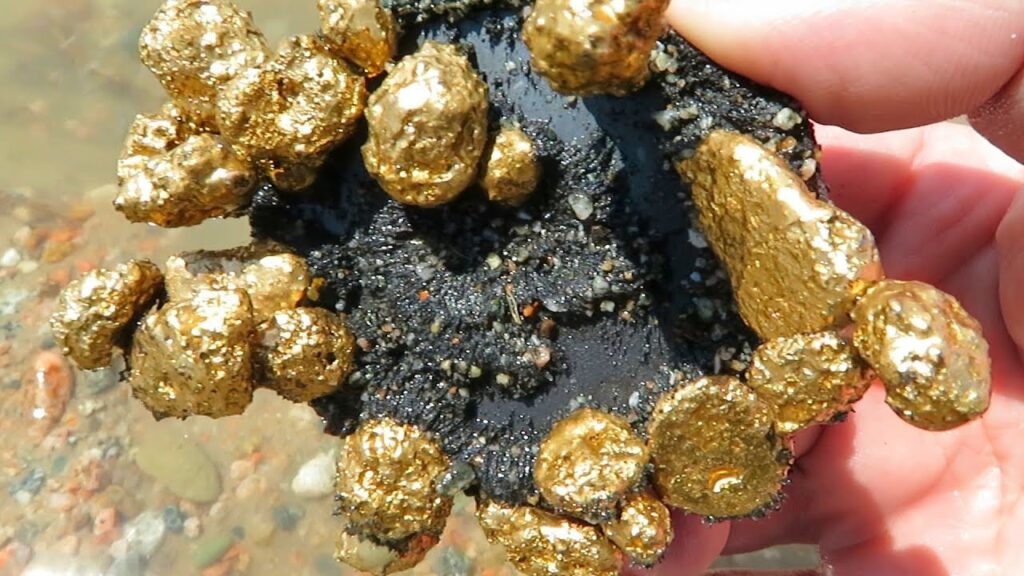Understanding The Properties Of Gold – Is It Magentic?
Gold is extremely valuable, and it’s a good place to invest your money when the economy is in dire straits. But with such value at stake, you also have to be cautious – counterfeiters can substitute lower-quality materials for gold, leaving you with worthless items.
Key Takeaways
- Gold is not magnetic
- If you drop a gold coin or a piece of gold jewellery somewhere hard to reach, you can’t use a magnet to get it back.
- Gold alloy is still not magnetic
This means it’s important to be sure of your gold items. There are a lot of ways you can do that, but we’re going to focus on a quick and easy way to tell: the magnet test.
Is gold magnetic? Read on to learn more about gold and magnetism! This guide will help you figure out if an item is real or fake with just a magnet.
RELATED: Gold IRA Reviews:
- American Hartford Gold
- Birch Gold
- Goldco
- BGASC Review
- Oxford Gold Group
- Augusta Precious Metals
- Goldsilver Reivew
What Is Gold?
Gold is an element with the symbol Au and an atomic number of 79. It’s bright, slightly orange-yellow, dense, malleable, and ductile. This metal is solid in a typical environment and mostly non-reactive.
It is relatively rare to find, and its main use is as a precious metal. Gold is most commonly used in coinage or jewellery or other artistic pieces. It’s also used in industry, most usually in corrosion-resistant electrical connectors.
Gold is the most malleable of all metals. This means it can be moulded into thin wires, down to a width of a single atom before it breaks. One gram of gold can be beaten into a sheet one square metre across. Since it’s very easy to work, gold is likely the earliest metal used by humans.
We’re going to focus on one specific quality of gold and what it means for you: its magnetism.
Is Gold Magnetic?
There’s a very simple answer to this: gold is not magnetic. We’ll cover which metals are and are not magnetic later on, but gold is not one of them. If you drop a gold coin or a piece of gold jewellery somewhere hard to reach, you can’t use a magnet to get it back.
There is one specific area where gold’s lack of magnetism can help: in proving whether a gold item is fake or real. Fake items typically have only a very thin layer of gold on top of a cheaper metal, and this cheaper metal is usually magnetic.
This means you can use the magnet test for gold. Take a neodymium “super magnet”, and attempt to stick it to the item in question. If the magnet sticks, then the item is definitely not real gold. If it slides off, then it might be real gold.
However, just because a magnet slides off, it does not automatically make it a real gold item. Counterfeiters these days have gotten wiser about the tests used to tell real gold from fake, and the better counterfeiters use non-magnetic metals in their fake items. Don’t forget to use other tests to tell whether a gold item is real to get more accurate confirmation.

Gold Fineness
Gold isn’t magnetic, but some gold items contain other metals. Items made out of gold are required to note how much gold is in them – this is its “fineness”.
The standard measurement of gold fineness is the “karat” (sometimes also spelled “carat”). Karats, expressed in parts out of 24, measure how much of the item is made out of gold. Think of it as a fraction – for example, 18-karat gold is 18/24 gold by mass.
These are the karat ratings you’re most likely to see:
- 24 karats: 99.9% gold, usually seen only as bullion coins or bars
- 22 karats: 91.7% gold and 8.3% other metals, typically used for bullion coins
- 18 karats: 75% gold and 25% other metals. Jewellery made out of 18K gold has the best colour and quality without compromising on durability.
- 14 karats: 58.4% gold and 41.6% other metals. It is the most common gold fineness used in jewellery, as it’s the best compromise between quality and price.
- 12 karats: 50% gold and 50% other metals.
- 10 karats: 41.7% gold and 58.3% other metals, the minimum possible fineness to be legally “gold” in the US. In Australia, the minimum karatage for legal gold is 9ct.
Gold Alloys
For all of gold’s virtues, it has some downsides. Gold might not corrode, but it’s soft and wears out easily. This isn’t a problem for gold coins or bullion since they’re largely going to be sitting in a vault or somewhere safe. However, a piece of jewellery made out of pure gold will scuff or dent too easily. Thus, pure gold jewellery is not made for everyday wear.
This is where gold alloys come in. They’re stronger than pure gold and more suitable for everyday wear. Common alloys are copper, nickel, titanium, silver, and zinc.
Alloys also give gold a different colour than usual. Some common alloys are therefore named after the colour they produce. For example, red gold is alloyed with copper, while white gold may incorporate nickel, zinc, or palladium.
Here are some common alloys and their metal percentages:
- Yellow gold: 91.67% gold, 5% silver, 2% copper, 1.33% zinc
- Red gold: 75% gold, 25% copper
- Rose gold: 75% gold, 22.25% copper, 2.75% silver
- Pink gold: 75% gold, 20% copper, 5% silver
- White gold: 75% gold, 10% palladium, 10% nickel, 5% zinc
- Grey-white gold: 75% gold, 17% iron, 8% copper
- Green gold: 75% gold, 20% silver, 5% copper
Note that these are not trademarked names. While these are common compositions for the gold alloys we’ve named, other possible compositions can bear the same name. For example, there’s more than one way to achieve white gold – some white gold is 75% gold and 25% platinum.
That said, if it’s alloyed, is gold magnetic?
Still, no. Even if the alloying metals are magnetic, the alloy itself is still not magnetic. This only happens if the proportion of gold is small enough that it can’t legally be called gold.
Magnetic And Non-Magnetic Metals
Most precious metals like gold, silver, and platinum are not magnetic. Some non-precious metals are also non-magnetic, like aluminium, copper, titanium, and tungsten. A canny counterfeiter will use non-magnetic metals to substitute for the item’s precious metal content.
So, if gold isn’t magnetic, what is? What lies underneath the gold coating of magnetic counterfeit items?
The three main magnetic metals are iron, nickel, and cobalt. A fake item made with these metals will attract a magnet.
The highest-quality fake gold items are made out of tungsten with a gold exterior. In addition to being non-magnetic, tungsten also has a density close to gold. A tungsten-based fake will pass most home tests, so exercise extreme caution.
Gold-Plated Items
Just because a magnet sticks to your gold item, it does not necessarily mean it’s an intentional fake. You may simply have a gold-plated item on your hands.
Gold-plated means that a piece of jewellery is made of one metal and covered in a layer of gold or gold alloy. This lets someone have a piece of jewellery that looks like gold without paying through the nose for it. It also means that the maker likely wasn’t intentionally trying to fake something. “Gold-plated” is a label regulated by the Federal Trade Commission.
The FTC has various labels based on how thick the gold layer is:
- Gold plate: A layer of gold at least 0.5 microns thick
- Gold electroplate: A layer of gold applied by an electrolytic process at least 0.175 microns thick
- Heavy gold electroplate: A layer of gold applied by an electrolytic process at least 2.5 microns thick
- Gold washed: A layer of gold applied by an electrolytic process less than 0.175 microns thick
Of course, none of this is real gold. If the metal beneath is magnetic, a magnet will still stick to the item despite the gold coating. It’s entirely up to you whether you’re fine with the various types of gold plating or only the real deal will do.
Frequently Asked Questions
Where is gold mined?
Gold is mined in many countries around the world. China is the top producer of gold, followed by Australia, Russia, the United States, and Canada. South Africa used to be near the top, but production has been falling in recent years. Ghana, Mexico, and Uzbekistan have also been climbing in the ranks of global gold producers.
How does gold interact with other elements?
Gold is generally non-reactive to other elements. It does not corrode or tarnish over time, and it is resistant to most acids and bases.
However, there are some interactions you may need to be cautious of. Gold reacts with chlorine at high temperatures, and it will form an alloy with mercury at room temperature.
Why invest in gold?
Gold is a popular investment for many reasons. For one, it has a long history of being used as a store of value. Gold is also scarce, durable, and easy to trade. Gold is often used as a hedge against inflation or economic uncertainty, as the price of gold typically stays steady even when the stock market is crashing.
What are some common gold bullion coins?
Gold bullion coins are usually made of 24 or 22 karat gold. The Australian Gold Nugget, Canadian Maple Leaf, and Chinese Gold Panda coins are all 24-karat coins. Meanwhile, American Gold Eagle and South African Krugerrand coins are 22-karat. These five gold bullion coins are the most common you’ll find on the market.
Final Thoughts
Is gold magnetic? No. This means you have an easy way to test if something is real gold or is just covered in a thin layer of it. It’s important to test the purity of your gold items, as this is what determines its market value.
Social Sharing
The owners of this website may be paid to recommend Goldco. The content on this website, including any positive reviews of Goldco and other reviews, may not be neutral or independent.
You can view Peter's Author page here.




